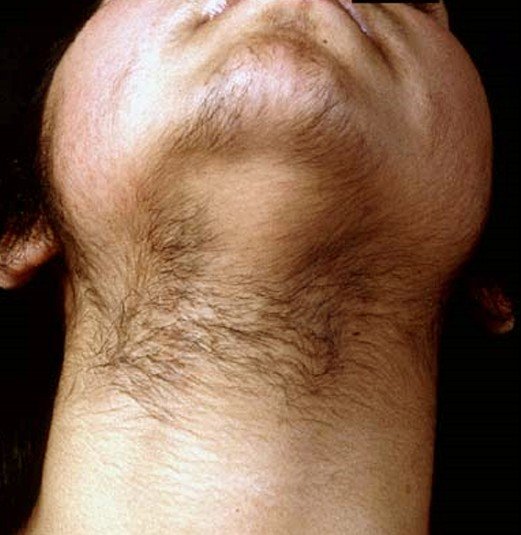Hirsutism
Last reviewed by Dr.Mary on August 7th, 2018.
What is Hirsutism?
Hirsutism is the excessive hair growth in women in areas of the body where hairs should have been minimal or absent. These areas include the face, the chest, and the areola. Hirsutism is a manifestation of male pattern of body hair that will cause more on cosmetic and psychological concerns; however, when hirsutism is accompanied by more serious masculine features, it can be considered a more serious condition and the manifestations may be a symptom of an underlying disease condition such as ovarian and adrenal neoplasm.
Hirsutism Symptoms
The following are the common presentation seen in individuals with hirsutism:
- Excess terminal hairs in a male-like pattern
- Assessment of hair growth in 9 key sites by the Ferriman-Gallwey model:
- Face
- Chest
- Areola
- Linea alba
- Upper and lower back
- Buttocks
- Inner part of the thigh
- External genitalia
- Acanthosis nigricans – this is a brown to black and poorly defined hyperpigmentation of the skin that are usually found in skin folds such as the posterior and lateral neck, armpits, groin, belly button, forehead and other areas. Acanthosis nigricans are thought to have been caused by insulin resistance which leads to increased insulin in the circulation, spilling over to the skin. This will then eventually lead to abnormal skin growth.
- Obesity
- Tumors in the ovaries; polycystic ovarian syndromes
- Adrenal cancer
- Signs of virility
- Signs of Cushing’s Syndrome
- Acne
- Alopecia
- Adrenal hyperplasia
Hirsutism Causes
Ovarian Cause
- The most common cause of increased androgen level and hirsutism is polycystic ovarian syndrome (PCOS).
- This will lead to menstrual irregularities, dysmenorrhea, glucose intolerance and hyperinsulinemia, and obesity.
- The increased level of insulin is taught to cause overstimulation of the ovaries to produce more androgen.
Hirsutism may also be seen in women who have other ovarian conditions that are associated with virilization, such as leutoma of pregnancy or a non-neoplastic lesion that includes enlargement of the ovaries.
- Arrhenoblastomas – these are ovarian tumors that promotes release of the male hormone, testosterone and other hormones.
- Leydig cell tumors – These tumors affect the male gonadal interstitium, which may lead to either virilizing or feminizing symptoms.
- Hilar cell tumors of the ovary may also lead to abnormalities in the secretion of male hormones.
Familial Hirsutism
This cause of hirsutism is not associated with oversecretion of androgen but is natural in some population.
Drug-Induced Hirsutism
There are drugs that induce androgenic effects when taken. Examples are the following: dehydroepiandrosterone sulfate (DHEA-S), testosterone, danazol, and anabolic steroids.
Adrenal Causes
Classic form of adrenal hyperplasia which occur in children often lead to hirsutism.
The following can be noted:
- Ambiguous genitalia
- Salt wasting symptoms
- Failure to thrive
- Masculine features
- Signs of virilization and menstrual abnormalities appear in adulthood
Other Causes
- Anorexia nervosa
- Acromegaly
- Hypothyroidism
- Hyperprolactinemia
- Porphyria
Treatment
The following are the known treatment methods used in managing the symptoms:
Hair Removal
Depilation – this manner of hair removal includes ordinary shaving and the use of chemicals such as thioglycolic acid.
Shaving can be done anytime and is inexpensive but shaving can promote regrowth, and as the hairs grow, they produce rough stubble.
Chemical depilation is best used in treating large areas and is useful for some patients that can’t afford the more expensive procedures such as electrolysis and laser. Chemical depilation may result to irritation and folliculitis because the procedure will separate the hair from its follicles by reducing the sulfide bonds.
Temporary epilation – this involves removal of the hair from its roots.
Plucking and tweezing are widely common method. This procedure though can lead to irritation, damage to hair follicles, hyperpigmentation, scarring, etc.
Waxing – this method can be painful because melted wax is applied to the skin surface. Once the melted wax cools, it is then removed abruptly peeling the skin off and the embedded hairs will be removed. Regular waxing will result to miniaturization of hairs and will eventually reduce the number of hairs.
Threading – this method is used in Arab countries which uses a cotton thread to pullout the hairs by the roots.
Radiation Therapy – although this has been used often in the past, but this is no longer recommended.
Permanent epilation – this is done by hair destruction through electrolysis, thermolysis, or its combination. Thermolysis uses a high-frequency alternating current while traditional electrolysis uses a galvanic direct current.
Laser – this method can treat larger areas and is much faster than electrolysis and thermolysis.
Laser can have skin-cooling effect which actually minimizes epidermal irritation or destruction during the procedure.
Pharmacologic Treatment – the use of antiandrogen medications are often administered combined with cosmetic hair removal technique. It is a must that drugs should be given continuously because once stopped, it will cause reversal of symptoms.
The following drugs are contraindicated during pregnancy:
- Estrogen-progestin oral contraceptives for ovarian suppression
- Antiandrogens – Androgen receptor blockade and inhibition
- Oral corticosteroids for adrenal suppression
- Finasteride – this is used for 5-Alpha-reductase inhibition, which blocks the conversion of testosterone to its active form dihydrotestosterone.
Surgery – if the cause of oversecretion of the hormone is an ovarian tumor, surgical removal of the tumor can alleviate the symptoms.
The following medications are used in treating hirsutism associated with androgen-excess syndrome, such as polycystic ovarian syndrome (PCOS)
- Antihypertensives – Spironolactone (Aldactone)
- Antiandrogens – block the production of androgen (It includes flutamide, cyproterone)
- Dermatologic Agents – Eflornithine cream acts as a growth inhibitor because it inhibits ornithine decarboxylase which is an enzyme that is needed for hair growth.
- Glucocorticoids – effective in reducing the levels of androgen (dexamethasone, prednisone).




